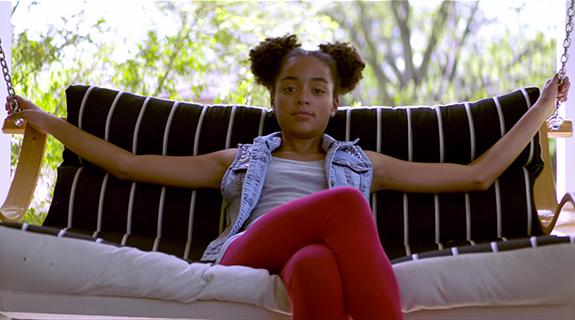The network that made “Lifetime movies” a household term has undergone dramatic growth spurts of late, adding original series such as Devious Maids, UnREAL and Dance Moms. Those breakouts sowed the seeds of a brand evolution.
“UnREAL was a game-changer for us. Now we’re doing things that are very premium, which is why critics are talking about us, ” says Val Albanese, SVP, brand creative at Lifetime. Edgier content has attracted younger viewers, including college-age women whose moms are Lifetime fans.
“We’ve been talking for some time about what our brand experience could or should be,” says Tim Nolan, SVP, marketing, Lifetime. “We saw an opportunity to expand our brand a little bit further and take on something with more of a point of view, something women could celebrate and own and want to be a part of instead of just watching.”
To ensure Lifetime was reaching women in the most effective ways possible,
Lifetime brought in branding agency Troika.
“Our understanding of womanhood—and of gender in general—is one of our most rapidly evolving cultural concepts,” says Susan Kresnicka, cultural anthropologist at Troika who created a multi-faceted study to form a “snapshot” of what it means to be a woman today. “We had women submit 30-second videos and answer a set of questions about every time gender or being a woman proved important, relevant, or meaningful in the course of everyday life. That wasn’t the only method we used, but it really did enable us to get a much bigger understanding of the benefits and challenges of womanhood and how they intersect within daily life.”
Once the data was in, one thing was clear: Women respond to images of strength. There was no close second. Kresnicka and her team pinpointed seven specific dimensions of strength:
- Speaking Up
- Breaking the Mold
- Forging a Path
- Persevering
- Accepting Vulnerability
- Being You
- Walking the Line
“This breaks down the stereotypical notions of what strength and female strength look like. It’s not the co-opting of male strength. It’s not an oversimplification at all. There are real complexities and nuances to it,” Kresnicka says.
“It gave us a jumping off point, to further evolve our brand.” Albanese says. It was also the start of Lifetime’s “Fempire” campaign, a key part of the brand evolution.
“The two pillars we’re really looking at are how to identify strength in a fun, earnest, important way for women, and how to talk about equality instead of feminism,” Nolan says. “Men can be part of the Fempire, too. Everyone is included.”
Next, Lifetime needed a fresh look to reflect that spectrum of female strength. Trollbäck + Company landed the job.
“That notion of strength really carried through to the way things were created and thought about,” says Elliott Chaffer, Trollbäck’s executive creative director. “When we made the toolkit, we made things in different ways and different formats that can hit different corners of the screen so they have ultimate flexibility to keep viewers inside the promo and not cut to a flat card, so you’re always able to keep pushing the strength through imagery.”
They incorporated “glitches” —the movement of things breaking apart and transitioning —to represent how everyone is constantly in transition, and can be many things at the same time.
“That ‘don’t define me, I’m not just one thing’ message really speaks to what we’re trying to reflect, not just with female strength, but with strength in general,” Albanese says. “It comes in many different shapes and sizes, just as people do. We wanted a cohesive look to reflect through shapes, colors and fonts that we’re constantly evolving and changing.”
“[Lifetime] wanted something that would continue to grow,” adds Elyse Roth, VP/EP, Trollbäck. “It wasn’t like a new paint job. [The network] wanted something that could have a life of its own, and grow, and build upon to create further tentacles into social media.”
Albanese describes its new on-air promos as “more disruptive.” Instead of going straight to end pages, content is allowed to play out to the very end, often with the Lifetime logo over the footage. “We’re making the most of our 30 or 60 seconds,” she says.
Graphics were the first obvious change. Next came a “sizzle” distributed initially on Facebook. Lifetime plans to create 10-15 “Fempire Moments” per year—some with talent from their shows, others from everyday people—saluting people doing great or inspiring things.
“This isn’t just on-air,” Albanese says. “We’re completely re-doing our website. It’s not only going to be a programming hub, it’s going to be a place where women can share stories. There will be editorial written around our content, there will be shared voices. What we keep saying is we’re creating a culture, not just an evolution. In order to do that, we have to keep feeding it.”
Nolan says some elements will be earnest, some will be light and fun, some may even be a bit absurd. “But it’s going to tie together completely—everything we do on-air, what we do with our consumer products, how it plays out as a global brand with our international partners, even how it seeps into our ad sales and distribution.”
The network’s new focus on strength already has opened up opportunities with brands that have never before advertised with Lifetime.
Not only has Troika’s research changed the way Lifetime approaches branding, advertising, and programming, it’s altered the company at its core.
“We changed the way we talk to ourselves internally,” Nolan says, “Do we have equality in our own workspace? Is our HR set up the right way? Are women and men treated equally here?”
Toward that end, Lifetime launched its “Broad Focus” initiative to create more opportunities for women to write, direct, develop and produce content for the network.
“It’s not just a new on-air look and brand statement to show that we’ve changed. We really have to live and breathe it,” Nolan says.
Tags:













































__twocolumncontent.jpg)











